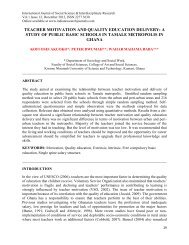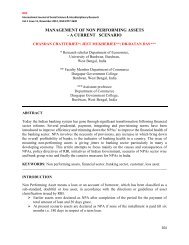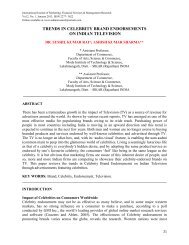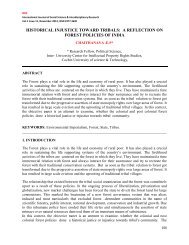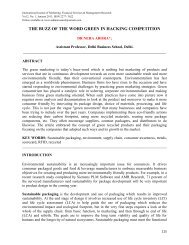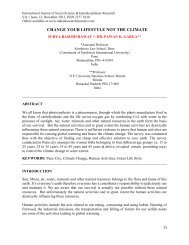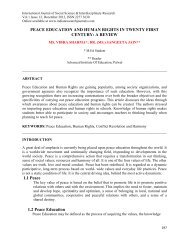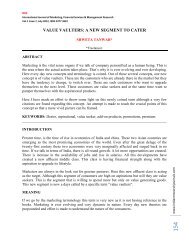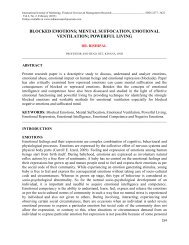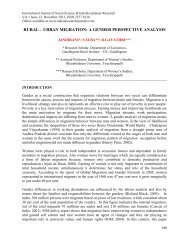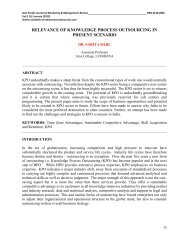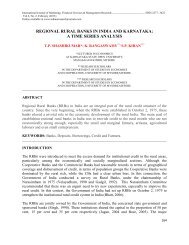application of remote sensing and gis for flood risk analysis: a case ...
application of remote sensing and gis for flood risk analysis: a case ...
application of remote sensing and gis for flood risk analysis: a case ...
You also want an ePaper? Increase the reach of your titles
YUMPU automatically turns print PDFs into web optimized ePapers that Google loves.
IRJC<br />
International Journal <strong>of</strong> Social Science & Interdisciplinary Research<br />
Vol.1 Issue 11, November 2012, ISSN 2277 3630<br />
APPLICATION OF REMOTE SENSING AND GIS FOR FLOOD RISK<br />
ANALYSIS: A CASE STUDY OF KRISHNA AND TUNGABADRA RIVER<br />
VALLEY<br />
MR. SATHISH S*, DR. NAGENDRA H.N** & MR. RAVI G***<br />
*Ph.D. Student,<br />
** Associate Pr<strong>of</strong>essor in Urban <strong>and</strong> Regional Planning,<br />
*** Ph.d. student) at Institute <strong>of</strong> Development Studies,<br />
University <strong>of</strong> Myosre,<br />
Manasagangothri, Mysore-570006.<br />
______________________________________________________________________________<br />
ABSTRACT<br />
River valley human settlements will be most effected by <strong>flood</strong>s due to dependence <strong>of</strong> water<br />
source <strong>and</strong> physical <strong>and</strong> social works. One effected <strong>flood</strong>s will distribute life fabric <strong>for</strong> five to ten<br />
years. This in turn changes migration pattern <strong>and</strong> relocation. Advances in <strong>remote</strong> <strong>sensing</strong><br />
technology <strong>and</strong> new satellite plat<strong>for</strong>ms such as ALOS (Advanced L<strong>and</strong> Observation Satellite)<br />
sensors widened the <strong>application</strong> <strong>of</strong> satellite data. One <strong>of</strong> the many fields that these technologies<br />
can be applied is to validate <strong>flood</strong> inundation models. For a long time <strong>flood</strong> extent from <strong>flood</strong><br />
inundation models were validated using the ground truth surveys which was not very much<br />
reliable. In this study <strong>flood</strong> extent was extracted from satellite images available <strong>for</strong> one in 50<br />
year <strong>flood</strong> event occurred on June 2008 in Krishna <strong>and</strong> Tungabhadra river valley in Karnataka.<br />
Then that was compared with the <strong>flood</strong> extent derived from the <strong>flood</strong> extent obtained <strong>for</strong> the 50-<br />
year rainfall using relevant models. Based on the <strong>flood</strong> extent <strong>and</strong> to develop, demonstrate <strong>and</strong><br />
validate an in<strong>for</strong>mation system <strong>for</strong> <strong>flood</strong> <strong>for</strong>ecasting, planning <strong>and</strong> management using <strong>remote</strong><br />
<strong>sensing</strong> data with the help <strong>of</strong> Flood Hazard Maps <strong>for</strong> different return periods (10, 20, 40, 50 <strong>and</strong><br />
100 years), Assess the population vulnerability <strong>and</strong> physical vulnerability <strong>of</strong> the lowest<br />
administrative division subjected to <strong>flood</strong>s, <strong>and</strong> using above results conduct a <strong>flood</strong> <strong>risk</strong> <strong>analysis</strong><br />
<strong>of</strong> the study area.<br />
A comprehensive prediction model will mitigate the <strong>risk</strong> to a greater extent. Availability <strong>of</strong><br />
technologies such as Remote Sensing <strong>and</strong> GIS( Geographic In<strong>for</strong>mation Systems) gives more<br />
reliable scenario to analyze <strong>and</strong> find solutions in policy framework. Post <strong>flood</strong> in<strong>for</strong>mation<br />
system is <strong>of</strong>ten r<strong>and</strong>om <strong>and</strong> patchy in its quality <strong>of</strong> data. Much <strong>of</strong> the physical observations <strong>and</strong><br />
extent <strong>of</strong> <strong>flood</strong> levels can be accurately modeled <strong>for</strong> effective <strong>analysis</strong>. Both the aspect <strong>of</strong> <strong>flood</strong><br />
<strong>risk</strong> <strong>and</strong> post <strong>flood</strong> evaluation has been studies in Krishna river valley topography plays a major<br />
role in spreading the level <strong>of</strong> water which affects normal life.<br />
KEYWORDS: Geographic In<strong>for</strong>matin System, Policy framework, <strong>flood</strong> <strong>for</strong>ecasting, population<br />
vulnerability, physical vulnerability.<br />
50
IRJC<br />
International Journal <strong>of</strong> Social Science & Interdisciplinary Research<br />
Vol.1 Issue 11, November 2012, ISSN 2277 3630<br />
1. INTRODUCTION<br />
Accurate <strong>and</strong> current <strong>flood</strong>plain maps can be the most valuable tools <strong>for</strong> avoiding severe social<br />
<strong>and</strong> economic losses from <strong>flood</strong>s. Accurately updated <strong>flood</strong>plain maps also improve public<br />
safety. Early identification <strong>of</strong> <strong>flood</strong>-prone properties during emergencies allows public safety<br />
organizations to establish warning <strong>and</strong> evacuation priorities. Armed with definitive in<strong>for</strong>mation,<br />
government agencies can initiate corrective <strong>and</strong> remedial ef<strong>for</strong>ts be<strong>for</strong>e disaster strikes<br />
(Chapman <strong>and</strong> Canaan, 2001).<br />
Sam U. Shamsi,(2002) in the report „GIS Applications in Floodplain Management‟ has conveyed<br />
that GIS is ideally suited <strong>for</strong> various <strong>flood</strong>plain management activities such as, base mapping,<br />
topographic mapping, <strong>and</strong> post-disaster verification <strong>of</strong> mapped <strong>flood</strong>plain extents <strong>and</strong> depths.<br />
For example, GIS was used to develop a River Management Plan <strong>for</strong> the Santa Clara River in<br />
Southern Cali<strong>for</strong>nia. A GIS overlay process was used to further plan ef<strong>for</strong>ts <strong>and</strong> identify<br />
conflicting uses along the river <strong>and</strong> areas <strong>for</strong> enhancing stakeholder objectives. A 1 inch = 400 ft.<br />
(1 cm = 122 m) scale base map was created to show topography, planimetric features, <strong>and</strong><br />
parcels. Attribute data were entered into a separate database <strong>and</strong> later linked to the appropriate<br />
map location. Six layers were created <strong>for</strong> <strong>flood</strong> protection related work: 100-year <strong>flood</strong>plain,<br />
100-year <strong>flood</strong> way, 25-year interim line, existing facilities, proposed facilities, <strong>and</strong> <strong>flood</strong><br />
deposition. The lessons learned from this mapping project indicate that GIS is useful in capturing<br />
<strong>and</strong> communicating a vast amount <strong>of</strong> in<strong>for</strong>mation about the study area <strong>and</strong> the river. While the<br />
use <strong>of</strong> GIS <strong>and</strong> the process to gather <strong>and</strong> record data were not without problems, the overall<br />
value <strong>of</strong> GIS was found to overweigh those challenges (Sheydayi, 1999).<br />
Floods are probably the most recurring, widespread, disastrous <strong>and</strong> frequent natural hazards <strong>of</strong><br />
the world. India is one <strong>of</strong> the worst <strong>flood</strong>-affected countries, being second in the world after<br />
Bangladesh <strong>and</strong> accounts <strong>for</strong> one fifth <strong>of</strong> global death count due to <strong>flood</strong>s. Total geographic area<br />
India is 328.7millian hectares, in which about 40 million hectares nearly 1/8th <strong>of</strong> India‟s<br />
geographical area is <strong>flood</strong>-prone. 19<br />
Along with this India has the highest occurrence <strong>of</strong> natural disasters in south-east Asia with<br />
about 85 percent <strong>of</strong> the country liable to be affected by one or the other disaster viz. avalanches<br />
cyclone, drought, earthquake, <strong>flood</strong>, l<strong>and</strong>slides, etc. There are also many environmental hazards,<br />
spontaneous or human-induced related to the natural <strong>for</strong>est or soil cover or over-exploitation <strong>of</strong><br />
agricultural l<strong>and</strong>. Of these about 63 percent <strong>of</strong> the total agricultural area is drought prone, while<br />
area devastated by annual or flash <strong>flood</strong>s is estimated to be about 12 to 15 percent <strong>of</strong> the area.<br />
The long coastline <strong>and</strong> the coastal areas are exposed to one or two pre or post monsoon cyclones<br />
every year. More than 50 percent <strong>of</strong> India‟s geographical area is vulnerable to seismic or<br />
geodynamical activity <strong>of</strong> varying intensity. These natural hazards are so frequent <strong>and</strong> so<br />
devastating that these affect the economic development. Social stability gets severely disturbed<br />
<strong>and</strong> inflicts untold human miseries leading to health hazards.<br />
51
IRJC<br />
International Journal <strong>of</strong> Social Science & Interdisciplinary Research<br />
Vol.1 Issue 11, November 2012, ISSN 2277 3630<br />
Although the occurrence <strong>of</strong> such disasters cannot be prevented or regulated, the proper<br />
<strong>application</strong> <strong>of</strong> scientific knowledge based on past experience can minimize the economic <strong>and</strong><br />
health consequences <strong>of</strong> the population.<br />
INTRODUCTION:<br />
The natural hazards can be listed as avalanches <strong>and</strong> l<strong>and</strong>slides in Himalayas, cyclones in coastal<br />
areas, drought in rain-scarcity areas, earthquakes in seismic <strong>and</strong> tectonic activities affected areas<br />
<strong>and</strong> <strong>flood</strong>s in heavy rainfall area. Hence effect <strong>of</strong> these hazards causes damages at various<br />
degrees to an extent <strong>of</strong> disaster, the phenomena <strong>of</strong> these kinds <strong>of</strong> disaster due to <strong>flood</strong> dem<strong>and</strong>s a<br />
systematic study.<br />
Disaster means a catastrophe, a calamity or mishap, a grave occurrence, which causes a serious<br />
disruption <strong>of</strong> the functioning <strong>of</strong> a society, causing widespread human, material or environmental<br />
losses exceeding the ability <strong>of</strong> the affected society to cope using only its resources.<br />
A Flood is defined as the overflow <strong>of</strong> areas that are normally submerged with water or a stream<br />
that has broken its normal confines or has accumulated due to lack <strong>of</strong> drainage. Floods are<br />
among the most common <strong>and</strong> destructive natural hazards causing extensive damage to<br />
infrastructure, public <strong>and</strong> private services, the Environment, the economy <strong>and</strong> devastation to<br />
human settlements. The <strong>flood</strong> has different types, they are; River <strong>flood</strong>, Coastal <strong>flood</strong>, urban<br />
<strong>flood</strong>, storm <strong>flood</strong> etc these may be flash <strong>flood</strong> or slow onset <strong>flood</strong>. 28<br />
B. Normal <strong>flood</strong>s are expected <strong>and</strong> generally welcomed in many parts <strong>of</strong> the world as they<br />
provide rich soil, water <strong>and</strong> a means <strong>of</strong> transport, but <strong>flood</strong>ing at an unexpected scale (damaging<br />
<strong>flood</strong>) <strong>and</strong> with excessive frequency causes damage to life, livelihoods <strong>and</strong> the environment.<br />
Over the past decades, the pattern <strong>of</strong> <strong>flood</strong>s across all continents has been changing, becoming<br />
more frequent, intense <strong>and</strong> unpredictable <strong>for</strong> local communities, particularly as issues <strong>of</strong><br />
development <strong>and</strong> poverty have led more people to live in areas vulnerable to <strong>flood</strong>ing. The<br />
Fourth Assessment Report (2007) <strong>of</strong> the Intergovernmental Panel on Climate Change (IPCC)<br />
predicts that „heavy precipitation events, which are very likely to increase in frequency, will<br />
augment <strong>flood</strong> <strong>risk</strong>‟. These <strong>flood</strong>s will affect life <strong>and</strong> livelihoods in human settlements in all<br />
areas, e.g., coastal zones, river deltas <strong>and</strong> mountains. Though there were continuous ef<strong>for</strong>ts to<br />
mitigate <strong>flood</strong> <strong>and</strong> its effects on victims.<br />
C. Floods by nature become a complex event <strong>and</strong> caused a range <strong>of</strong> human vulnerabilities,<br />
inappropriate development planning <strong>and</strong> climate variability with the exception <strong>of</strong> flash <strong>flood</strong>s,<br />
whose scale <strong>and</strong> nature are <strong>of</strong>ten less certain. Hence it requires more comprehensive studies<br />
about <strong>flood</strong> to <strong>for</strong>mulate appropriate strategies to mitigate <strong>flood</strong> <strong>and</strong> its impacts.<br />
NEED FOR THE STUDY<br />
Floods are an endemic problem in India. The National Commission on Floods, more commonly<br />
known by its Hindi name „Rashtriya Barh Aayog‟, in 1980 estimated that about 40 mha <strong>of</strong> area is<br />
<strong>flood</strong>-prone. This was later revised to 33.5 mha. On an average, 7.5 mha Area is affected by<br />
<strong>flood</strong>s in any one year, in some or other part <strong>of</strong> the country. Large <strong>flood</strong> events capture the<br />
52
IRJC<br />
International Journal <strong>of</strong> Social Science & Interdisciplinary Research<br />
Vol.1 Issue 11, November 2012, ISSN 2277 3630<br />
Public attention. Inundations in Mumbai in July 2005, Surat in August 2006, Bihar in August<br />
2008 due to breach in Kosi embankments, Karnataka in October 2009 are some <strong>of</strong> the <strong>flood</strong><br />
events in the recent past that have resulted in considerable discussion in the public space. Every<br />
major <strong>flood</strong> event is immediately followed by a <strong>flood</strong> <strong>of</strong> a different kind – „scholarly‟ articles<br />
analyzing the <strong>flood</strong> event <strong>and</strong> the current <strong>flood</strong> management paradigm. Almost all such articles<br />
say more or less the same thing. some studies says the <strong>flood</strong> is described as man-made, the<br />
technology based <strong>flood</strong> management paradigm is declared as all wrong, the technocrats are<br />
admonished <strong>for</strong> thinking that they can concur the nature <strong>and</strong> finally, it is asserted that our<br />
ancestors had mastered the art <strong>of</strong> living with <strong>flood</strong>s, which we should also adopt.<br />
As <strong>flood</strong> dynamics are more complex underst<strong>and</strong>ing <strong>flood</strong> management requires study <strong>of</strong><br />
hydrology, open channel hydraulics, <strong>and</strong> river morphology. Amongst those who comment on<br />
<strong>flood</strong> Management studied on <strong>flood</strong>s have found some solution <strong>for</strong> efficient <strong>flood</strong> management<br />
<strong>and</strong> mitigate <strong>flood</strong> along with further studies on lakes <strong>and</strong> rivers have symbiotic relationship in<br />
term <strong>of</strong> exchange <strong>of</strong> water inflow <strong>and</strong> outflow. 3<br />
However Reliable <strong>and</strong> precise estimation <strong>of</strong> <strong>flood</strong>s is critical <strong>for</strong> efficient <strong>flood</strong> management <strong>and</strong><br />
surface water planning. Hydrolo<strong>gis</strong>ts use catchment <strong>and</strong> hydrological data to establish regional<br />
relationships between mean annual <strong>flood</strong> <strong>and</strong> various catchment <strong>and</strong> rainfall characteristics. The<br />
relationship is used <strong>for</strong> predicting <strong>flood</strong>s <strong>of</strong> different return periods.<br />
Historically many human settlements were along the rivers but people chose the highest possible<br />
points thus minimizing chance <strong>of</strong> <strong>flood</strong>s. But with increasing population <strong>of</strong> the cities, settlements<br />
had to occur at lower <strong>and</strong> lower levels <strong>and</strong> closer to river thus increasing chances <strong>for</strong> <strong>flood</strong>s. This<br />
had happened in many Indian settlements. At the time when dam was built perhaps rivers had<br />
good carrying capacity <strong>and</strong> later on downstream as settlement encroaches the river catchments<br />
<strong>and</strong> their natural watercourses have caused <strong>flood</strong>.(5th WSEAS Int. Conf. on environment,<br />
ecosystems <strong>and</strong> development, (2007)).<br />
Floods are a naturally occurring hazard that becomes disasters when they affect human<br />
settlements. The magnitude <strong>and</strong> frequency <strong>of</strong> <strong>flood</strong>s is <strong>of</strong>ten increased as a result <strong>of</strong> the following<br />
human actions.<br />
Settlement on <strong>flood</strong> plains contributes to <strong>flood</strong>ing disasters by endangering humans <strong>and</strong> their<br />
assets. However, the economic benefits <strong>of</strong> living on a <strong>flood</strong>plain outweigh the dangers <strong>for</strong> some<br />
communities. Pressures from population growth <strong>and</strong> shortages <strong>of</strong> l<strong>and</strong> also promote settlement<br />
on <strong>flood</strong>plains. Floodplain development can also alter water channels, which if not well planned<br />
can contribute to <strong>flood</strong>s. Urbanization also contributes to urban <strong>flood</strong>ing in four major ways.<br />
1. Roads <strong>and</strong> buildings cover the l<strong>and</strong>,<br />
2. Preventing infiltration so that run<strong>of</strong>f <strong>for</strong>ms Artificial streams.<br />
3. The network <strong>of</strong> drains in urban areas may deliver water <strong>and</strong> fill natural channels more<br />
rapidly than naturally occurring drainage, or may be insufficient <strong>and</strong> overflow.<br />
53
IRJC<br />
International Journal <strong>of</strong> Social Science & Interdisciplinary Research<br />
Vol.1 Issue 11, November 2012, ISSN 2277 3630<br />
4. Natural or artificial channels may become constricted due to debris, or obstructed by<br />
river facilities, impeding drainage <strong>and</strong> overflowing the catchment areas.<br />
De<strong>for</strong>estation <strong>and</strong> removal <strong>of</strong> root systems increases run<strong>of</strong>f. Subsequent erosion causes<br />
sedimentation in river channels, which decreases their capacity intern causes <strong>flood</strong> during rainy<br />
season. Failure to maintain or manage drainage systems, dams, <strong>and</strong> levee bank protection in<br />
vulnerable areas also contributes to <strong>flood</strong>ing.<br />
The flash <strong>flood</strong> common in many regions results from the outbreak <strong>of</strong> dammed lakes. These<br />
dammed lakes can break resulting in flash <strong>flood</strong>. Hundreds <strong>of</strong> lives <strong>and</strong> millions <strong>of</strong> rupees worth<br />
<strong>of</strong> property <strong>and</strong> investment in high-cost infrastructure are lost in the region every year due to<br />
l<strong>and</strong>slides, debris flows, <strong>and</strong> <strong>flood</strong>s, along with the destruction <strong>of</strong> scarce agricultural l<strong>and</strong>s. In the<br />
last decade <strong>flood</strong>s killed many persons <strong>and</strong> affected billion people worldwide. And the number<br />
<strong>of</strong> events as well as deaths is increasing significantly higher in Asia than elsewhere, <strong>and</strong> among<br />
all water-induced disasters this number is much higher <strong>for</strong> flash <strong>flood</strong>s .<br />
The Government <strong>of</strong> India (GOI) has been spending large amount <strong>of</strong> money on <strong>flood</strong> control, its<br />
main focus is on irrigation. GOI has launched „National Flood Control Program‟ in 1954 <strong>and</strong> set<br />
up the “Rashtriya Barh Ayog” (RBA), “National Flood Commission”, in 1976 to evolve a<br />
coordinated, integrated <strong>and</strong> scientific approach to the <strong>flood</strong> control problems in the country <strong>and</strong><br />
to draw out a national plan fixing priorities <strong>for</strong> implementation in the future. The RBA in its<br />
report in 1980 identified <strong>flood</strong> prone districts in many states <strong>of</strong> India including Karnataka <strong>and</strong><br />
also extended services by proposing strategies to mitigate impact <strong>of</strong> <strong>flood</strong>. It is interesting to note<br />
that despite <strong>of</strong> these ef<strong>for</strong>ts, India is still repeatedly witnessing massive <strong>flood</strong> hazards<br />
Under the concepts <strong>of</strong> integrated development many dams were built. Dams in India <strong>and</strong><br />
anywhere else are made <strong>for</strong> different purposes including power generation, irrigation, <strong>flood</strong><br />
prevention, l<strong>and</strong> reclamation, <strong>and</strong> water diversion. Given the multiple objectives <strong>of</strong> dams, dam<br />
management <strong>and</strong> food control involves different stakeholders with different interests <strong>and</strong><br />
responsibilities, but these ef<strong>for</strong>ts makes the <strong>flood</strong> control related decision making a complex<br />
process. This has become a quite common phenomenon in every states <strong>of</strong> India, including<br />
Karnataka which has been no exception as far as sufferings inflicted by natural <strong>and</strong> man-made<br />
hazards are concerned. The state has been frequented by cyclones, <strong>flood</strong>s, droughts, l<strong>and</strong>slides,<br />
subsidence <strong>and</strong> occasional earthquakes. Progressive trends <strong>of</strong> any region are controlled to a large<br />
extent by the requirements <strong>of</strong> the inhabitants, agriculture, industries, transportation,<br />
communication, education <strong>and</strong> Culture, which generally <strong>for</strong>m the vulnerability attributes.<br />
Because <strong>of</strong> the high population density <strong>and</strong> concentration <strong>of</strong> industrial <strong>and</strong> agricultural activities<br />
across Karnataka, <strong>risk</strong> or vulnerability to natural or man-made disasters is particularly high. With<br />
increasing developmental activities in high-hazard zones, e.g. the coastal regions, the<br />
vulnerability scenario appears to be worsening with time.<br />
But recently <strong>flood</strong> caused in the north Karnataka region have attracted the pr<strong>of</strong>essionals on the<br />
cause <strong>of</strong> <strong>flood</strong> <strong>and</strong> <strong>flood</strong> victims. The devastating <strong>flood</strong>s <strong>of</strong> 2009 in Karnataka almost swept<br />
away 13 Districts. These <strong>flood</strong>s created havoc in this affected region, resulting in immense<br />
destruction <strong>of</strong> human life, property <strong>and</strong> crops.<br />
54
IRJC<br />
International Journal <strong>of</strong> Social Science & Interdisciplinary Research<br />
Vol.1 Issue 11, November 2012, ISSN 2277 3630<br />
Most members <strong>of</strong> these communities are laborers, peasants <strong>and</strong> artisans belonging to backward<br />
or scheduled castes. Many <strong>of</strong> them work on meager daily wages <strong>and</strong> debt bondage is their way <strong>of</strong><br />
life. When affected by the <strong>flood</strong>s, they lost employment or their most valuable <strong>and</strong> <strong>of</strong>ten only<br />
asset, the household.<br />
Moreover, the disaster had a stark impact on the children, many <strong>of</strong> whom lost parents <strong>and</strong> other<br />
family members. They were in a very fragile environment that negatively impacted their<br />
physical, mental, <strong>and</strong> psychosocial development, <strong>and</strong> existing resources did not adequately meet<br />
their needs. Also there were no such sincere ef<strong>for</strong>ts to comprehend the position life <strong>of</strong> <strong>flood</strong><br />
victims. No comprehensive study has been done in the above aspect generally human settlement<br />
development <strong>and</strong> its future expansion. Very little ef<strong>for</strong>t is made to plan <strong>for</strong> the probable <strong>flood</strong>s;<br />
most <strong>of</strong> the studies are in disaster management <strong>and</strong> after <strong>flood</strong> emergency ef<strong>for</strong>t planning. Which<br />
involves the immediate disposal <strong>of</strong> budget <strong>and</strong> implementation <strong>of</strong> measures unscientifically? 4<br />
Dileep Mavalankar , Amit Kumar Srivastava (2008) .<br />
Hence a systematic approach is needed to underst<strong>and</strong> the causes <strong>and</strong> consequence s <strong>of</strong> <strong>flood</strong> <strong>and</strong><br />
<strong>for</strong>mulate effective measures against <strong>flood</strong> hazards.<br />
STUDY AREA<br />
In general most <strong>of</strong> the human settlements in Karnataka were established very near to the main<br />
river course <strong>and</strong> other water bodies with less knowledge <strong>of</strong> probable disasters. This study will<br />
investigate in a designated area <strong>of</strong> recent <strong>flood</strong>s experienced in <strong>flood</strong> affected villages in Raichur<br />
district <strong>of</strong> northern part <strong>of</strong> Karnataka under Krishna <strong>and</strong> Tungabhadra river basin.<br />
In the recent devastating <strong>flood</strong>s <strong>of</strong> October 2009 almost swept away 13 Districts <strong>of</strong> Karnataka<br />
state i.e. Belgaum, Bijapur, Dharwad, Gadag, Haveri, Karwar, Gulgarga, Bidar, Raichur, Bellary,<br />
Koppala, Bagalkote <strong>and</strong> Davangere. These <strong>flood</strong>s created immense destruction <strong>of</strong> human life,<br />
property <strong>and</strong> crops. It left a trial <strong>of</strong> death <strong>and</strong> destruction with lakhs <strong>of</strong> people losing their<br />
belongings <strong>and</strong> their lives severely disrupted. The most destructive <strong>flood</strong>s washed out several<br />
villages on the river banks, 6.55 lakh houses were devastated <strong>and</strong> crops in over 22 lakh hectares<br />
were inundated. 229 peoples lost their lives <strong>and</strong> 7882 live stocks perished. A total <strong>of</strong> 4292<br />
villages were affected in various degree have caused a loss <strong>of</strong> over an estimated amount in<br />
rupees 18,500 crores that include both public <strong>and</strong> privately- owned properties. In the post <strong>flood</strong><br />
measures about 345 villages were proposed to relocate with other kind <strong>of</strong> relief measures <strong>for</strong> less<br />
affected villages.<br />
Table showing the names <strong>of</strong> district <strong>and</strong> number <strong>of</strong> villages to be relocated:<br />
55
IRJC<br />
International Journal <strong>of</strong> Social Science & Interdisciplinary Research<br />
Vol.1 Issue 11, November 2012, ISSN 2277 3630<br />
The delineated area <strong>of</strong> study has been chosen to get proper representation <strong>of</strong> various types <strong>of</strong><br />
conditions <strong>of</strong> <strong>flood</strong> damage. The Raichur district has both Krishna <strong>and</strong> Tungabhadra basin on<br />
either side. This will give ample scope <strong>for</strong> recommendation <strong>and</strong> study the varied conditions<br />
existing <strong>for</strong> <strong>flood</strong> mitigation proposals. 9<br />
Study area pr<strong>of</strong> ile;<br />
LOCATION & HISTORY: Raichur district is situated in north eastern part <strong>of</strong> Karnataka state. It<br />
falls in the northern maiden region, between 15º 33‟- 16º 34‟ North latitudes <strong>and</strong> 76º 14‟- 77º 36‟<br />
East longitudes <strong>and</strong> also between the two major rivers namely the Krishna <strong>and</strong> the Tungabhadra.<br />
The district is bounded on the north by Gulbarga on the east by the Mahbubnagar district <strong>of</strong><br />
Andhra Pradesh. Administrative divisions <strong>of</strong> the district are shown in Fig.1.<br />
56
IRJC<br />
International Journal <strong>of</strong> Social Science & Interdisciplinary Research<br />
Vol.1 Issue 11, November 2012, ISSN 2277 3630<br />
Fig 1. Location Map<br />
Figure 2. A schematic diagram <strong>of</strong> the Krishna River basin, showing all proposed inter-basin<br />
water transfers in <strong>and</strong> out <strong>of</strong> the basin (black lines with numbers) together with flow measuring<br />
points (stations) <strong>for</strong> which some observed flow data were available <strong>for</strong> the study. Link numbers<br />
are circled <strong>and</strong> correspond to the overall NRLP numbering system. Station numbering is <strong>for</strong><br />
identification purposes only. Due to the low quality, short records or inappropriate location<br />
relative to the link points, only a few <strong>of</strong> the shown stations are usable. These include record at<br />
station 3 (Krishna at Agraharam) <strong>and</strong> part <strong>of</strong> the record at station 1 (Krishna at Vijayavada).<br />
57
IRJC<br />
International Journal <strong>of</strong> Social Science & Interdisciplinary Research<br />
Vol.1 Issue 11, November 2012, ISSN 2277 3630<br />
A study <strong>of</strong> various types <strong>of</strong> <strong>flood</strong> <strong>and</strong> their characteristics in general will be required to<br />
underst<strong>and</strong> the characteristics <strong>of</strong> <strong>flood</strong> in the villages <strong>of</strong> Raichur district under Krishna <strong>and</strong><br />
Tungabhadra river valley region. This study will be carried out from secondary sources.<br />
However primary survey will be conducted<br />
1. To study the characteristics, causes <strong>and</strong> impact <strong>of</strong> <strong>flood</strong> affected villages in the study area<br />
2. To study the efficacy <strong>of</strong> existing Post <strong>flood</strong> rural planning <strong>and</strong> development strategies<br />
<strong>for</strong> the <strong>flood</strong> affected villages in the study area.<br />
As the government has intervened in the planning <strong>and</strong> development processes in the <strong>flood</strong><br />
affected regions some secondary in<strong>for</strong>mation will also be available, the same will be used to<br />
underst<strong>and</strong> the characteristics, causes <strong>and</strong> impact <strong>of</strong> <strong>flood</strong>. Based on the research study effective<br />
Post <strong>flood</strong> rural planning <strong>and</strong> development strategies will be proposed <strong>for</strong> the type <strong>of</strong> <strong>flood</strong><br />
which generally prevailed in the study area.<br />
To underst<strong>and</strong> the causes <strong>for</strong> <strong>flood</strong> in the villages a detailed study will be carried out on the <strong>flood</strong><br />
phenomena in the study area by referring to its past recorded in<strong>for</strong>mation. Also a field survey<br />
(general enquiries <strong>and</strong> observation) will be conducted to study effects <strong>of</strong> <strong>flood</strong> on the village<br />
settlements. The effect <strong>of</strong> <strong>flood</strong> has been studied categorically in terms <strong>of</strong> its implications on<br />
social, economic <strong>and</strong> physical structure <strong>of</strong> villages.<br />
A set <strong>of</strong> data will be collected regarding the planning measures that have been undertaken during<br />
the <strong>flood</strong> <strong>and</strong> on the post effects <strong>of</strong> <strong>flood</strong>. Based on the data <strong>analysis</strong> <strong>and</strong> literature <strong>case</strong> studies,<br />
some planning suggestions were proposed <strong>for</strong> the effective rehabilitation processes <strong>of</strong> a <strong>flood</strong><br />
affected villages.<br />
The study will be carried out by collecting data, from both primary <strong>and</strong> secondary sources:<br />
‣ Detailed mapping <strong>of</strong> the settlement pattern <strong>and</strong> topographic features <strong>for</strong> delineating the<br />
study area.<br />
‣ Hydrology <strong>and</strong> geological in<strong>for</strong>mation to identify the <strong>flood</strong> zones, major drainage system<br />
<strong>of</strong> the region <strong>and</strong> other aspects related to select the proposed area <strong>for</strong> rehabilitation.<br />
‣ Causes <strong>of</strong> the <strong>flood</strong> <strong>and</strong> their effects on socio-economic <strong>and</strong> physical structure <strong>of</strong> the<br />
village.<br />
‣ Data that can support identification <strong>of</strong> problems in the planning measures under taken by<br />
the concerned authorities <strong>and</strong> their efficacy in attaining the requirements <strong>of</strong> the <strong>flood</strong><br />
victims.<br />
Three Methods <strong>of</strong> GIS Linkage<br />
According to a literature review <strong>of</strong> GIS <strong>application</strong>s in computer modeling conducted by Heaney<br />
et al. (1999) <strong>for</strong> the U.S. Environmental Protection Agency (EPA), Shamsi (1998, 1999) <strong>of</strong>fers a<br />
useful taxonomy to define the different ways a GIS can be linked to computer models. The three<br />
methods <strong>of</strong> GIS linkage defined by Shamsi (2001) illustrated in Figure 2 are:<br />
58
IRJC<br />
International Journal <strong>of</strong> Social Science & Interdisciplinary Research<br />
Vol.1 Issue 11, November 2012, ISSN 2277 3630<br />
1. Interchange method<br />
2. Interface method<br />
3. Integration method<br />
Interchange Method<br />
The interchange method employs a batch processing approach to interchange (transfer) data<br />
between a GIS <strong>and</strong> a computer model. In this method, there is no direct link between the GIS <strong>and</strong><br />
the model. Both the GIS <strong>and</strong> the model are run separately <strong>and</strong> independently. The GIS database<br />
is pre-processed to extract model input parameters, which are manually copied into a model<br />
input file. Similarly, model output data are manually copied in the GIS to create a new layer <strong>for</strong><br />
presentation mapping purposes. This is <strong>of</strong>ten the easiest method <strong>of</strong> using a GIS in computer<br />
models, <strong>and</strong> it is the method used most at the present time. Using GIS s<strong>of</strong>tware to extract<br />
<strong>flood</strong>plain cross-sections from DEM data or run<strong>of</strong>f curve numbers from l<strong>and</strong> use <strong>and</strong> soil layers<br />
are some examples <strong>of</strong> the interchange method.<br />
Interface Method<br />
The interface method provides a direct link to transfer in<strong>for</strong>mation between the GIS <strong>and</strong> the<br />
model. The interface method consists <strong>of</strong> at least the following two components:<br />
1. A pre-processor, which analyzes <strong>and</strong> exports the GIS data to create model input files; <strong>and</strong><br />
59
IRJC<br />
International Journal <strong>of</strong> Social Science & Interdisciplinary Research<br />
Vol.1 Issue 11, November 2012, ISSN 2277 3630<br />
2. A post-processor, which imports the model output <strong>and</strong> displays it as a GIS layer.<br />
The interface method basically automates the data interchange method. The automation is<br />
accomplished by adding model-specific menus or buttons to the GIS s<strong>of</strong>tware interface. The<br />
model is executed independently from the GIS; however, the input file is created, at least<br />
partially, from within the GIS. The main difference between the interchange <strong>and</strong> interface<br />
methods is the automatic creation <strong>of</strong> a model input file.<br />
U.S. Army Corps <strong>of</strong> Engineers HEC-GeoRAS s<strong>of</strong>tware is a good example <strong>of</strong> the interface<br />
method. Developed as an ArcView GIS extension, GeoRAS allows users to expediently create<br />
input data <strong>for</strong> their HEC-RAS models. Additional GeoRAS in<strong>for</strong>mation is provided below.<br />
Integration Method<br />
GIS integration is a combination <strong>of</strong> a model <strong>and</strong> a GIS such that the combined program <strong>of</strong>fers<br />
both the GIS <strong>and</strong> the modeling functions. This method represents the closest relationship<br />
between GIS <strong>and</strong> <strong>flood</strong>plain models. Two integration approaches are possible:<br />
1. GIS Based Integration: In this approach, modeling modules are developed in or are called<br />
from a GIS. All the four tasks <strong>of</strong> creating model input, editing data, running the model,<br />
<strong>and</strong> displaying output results are available in GIS. There is no need to exit the GIS to edit<br />
the data file or run the model. EPA's BASINS s<strong>of</strong>tware is a good example <strong>of</strong> this method.<br />
2. Model Based Integration: In this method GIS modules are developed in or are called from<br />
a computer model. Computation Hydraulics Int.'s (http://www.chi.on.ca/) PCSWMM GIS<br />
s<strong>of</strong>tware is a good example <strong>of</strong> this method.<br />
Because development <strong>and</strong> customization tools within most GIS packages provide relatively<br />
simple programming capability, the first approach provides limited modeling power. Because it<br />
is difficult to program all the GIS functions in a <strong>flood</strong>plain model, the second approach provides<br />
limited GIS capability. Applications are being developed to connect HEC-HMS <strong>and</strong> HEC-RAS<br />
models in a single ArcView GIS environment that would allow users to move easily from a<br />
DEM to a <strong>flood</strong>plain map within a single program (Kopp, 1998).<br />
Conclusion:<br />
Remote <strong>sensing</strong> data accumulated from past ten years <strong>and</strong> GIS data base <strong>of</strong> comm<strong>and</strong> area will<br />
give accurate progressive <strong>and</strong> environmental aspects <strong>for</strong> the best use <strong>for</strong> framing policy<br />
decisions. The study area <strong>of</strong> Raichur district has both Krishna <strong>and</strong> Tungabhadra river valley with<br />
both posing different set <strong>of</strong> in<strong>for</strong>mation‟s <strong>for</strong> specific policy framework in terms <strong>of</strong> settlement<br />
pattern <strong>and</strong> maintenance <strong>of</strong> post <strong>flood</strong> social economical <strong>and</strong> infrastructure fabric.<br />
One <strong>of</strong> the main aim <strong>of</strong> study is to take accurate decisions on future settlement pattern in order to<br />
avoid disaster effect in present river valley. Many ef<strong>for</strong>ts <strong>for</strong> disaster management by providing<br />
housing solution in upl<strong>and</strong> locations have failed to bring a change in the social fabric because <strong>of</strong><br />
locational disadvantage.<br />
60
IRJC<br />
International Journal <strong>of</strong> Social Science & Interdisciplinary Research<br />
Vol.1 Issue 11, November 2012, ISSN 2277 3630<br />
Funding <strong>and</strong> mitigation ef<strong>for</strong>ts are mostly aimed at physical infrastructure shifting, which are not<br />
used by the recipients. Flood aid <strong>and</strong> finance spread over years to rehabilitate will not be<br />
effective to get desired expected satisfaction. Study suggest the redevelopment <strong>of</strong> settlements in<br />
existing locations with emphasis on rapid <strong>flood</strong> evacuation <strong>and</strong> built infrastructure at higher floor<br />
levels on existing settlements.<br />
Flow <strong>and</strong> direction <strong>of</strong> water can be rapidly drained by creating infrastructure <strong>for</strong> the purpose.<br />
Study observes the extreme conditions occur only during first <strong>and</strong> second week <strong>of</strong> august during<br />
later part <strong>of</strong> the monsoon. It happens only <strong>for</strong> four to six days <strong>and</strong> disaster occurs in first four<br />
hours <strong>of</strong> the peak period. Drainage takes more than a week to clear because <strong>of</strong> natural plain<br />
l<strong>and</strong>s. Many newly built houses have elevation <strong>of</strong> plinth raised to one meter to greatly mitigate<br />
<strong>flood</strong> water at its highest peak time. Drafting the <strong>flood</strong> maps <strong>and</strong> implementing the decisions on<br />
safe <strong>flood</strong> levels will be one <strong>of</strong> the most technical <strong>and</strong> managerial skills to be learnt in these<br />
disaster experience. Remote <strong>sensing</strong> <strong>and</strong> GIS will be <strong>of</strong> immense use in framing policy guide<br />
lines.<br />
References:<br />
1. Chapman, J. B. <strong>and</strong> W.D. Canaan (2001). "Flood Maps are Key to Better Flood Damage<br />
Control." CE News, March 2001, 58-60.<br />
2. Dileep Mavalankar , Amit Kumar Srivastava (2008) Lessons from Massive Floods <strong>of</strong><br />
2006 in Surat City: A framework <strong>for</strong> Application <strong>of</strong> MS/ORTechniques to Improve Dam<br />
Management to Prevent Flood , Public Systems Group Paper presented at: Third National<br />
Conference on Management Science <strong>and</strong> Practices (MSP) 2008 held at IIM Ahmedabad,<br />
organized by ORSI Ahmedabad Chapter, Dated March 22-24, 2008.<br />
3. Kopp, S. (1998). "Developing a Hydrology Extension <strong>for</strong> ArcView Spatial Analyst." Arc<br />
User, Esri, April-June 1998, 18-20.<br />
4. Sam U. Shamsi(2002), Ph.D., P.E. GIS Applications in Floodplain Management, report.<br />
5. Shamsi, U.M. (1998). "ArcView Applications in SWMM Modeling." Chapter 11 in<br />
Advances in Modeling the Management <strong>of</strong> Stormwater Impacts, Edited by W. James,<br />
Vol. 6. Computational Hydraulics International, Guelph, Ontario, Canada. 219-233.<br />
6. Shamsi, U.M. (1999). "GIS <strong>and</strong> Water Resources Modeling: State-<strong>of</strong>-the-Art." Chapter 5<br />
in New Applications in Modeling Urban Water Systems, Edited by W. James,<br />
Computational Hydraulics International, Guelph, Ontario, Canada, 93-108.<br />
7. Shamsi, U.M. (2001). GIS <strong>and</strong> Modeling Integration. CE News, Vol. 13, No. 6, July<br />
2001, p 46-49.<br />
8. Sheydayi, A. (1999). "GIS Facilitates River Management Plan Development." Watershed<br />
& Wet Weather Technical Bulletin, WEF, January 1999, 10-12.<br />
9. The Fourth Assessment Report (2007) <strong>of</strong> the Intergovernmental Panel on Climate Change<br />
(IPCC)(4) 5th WSEAS Int. Conf. on environment, ecosystems <strong>and</strong> development,<br />
Tenerife, Spain, December 14-16, 2007 306<br />
61



